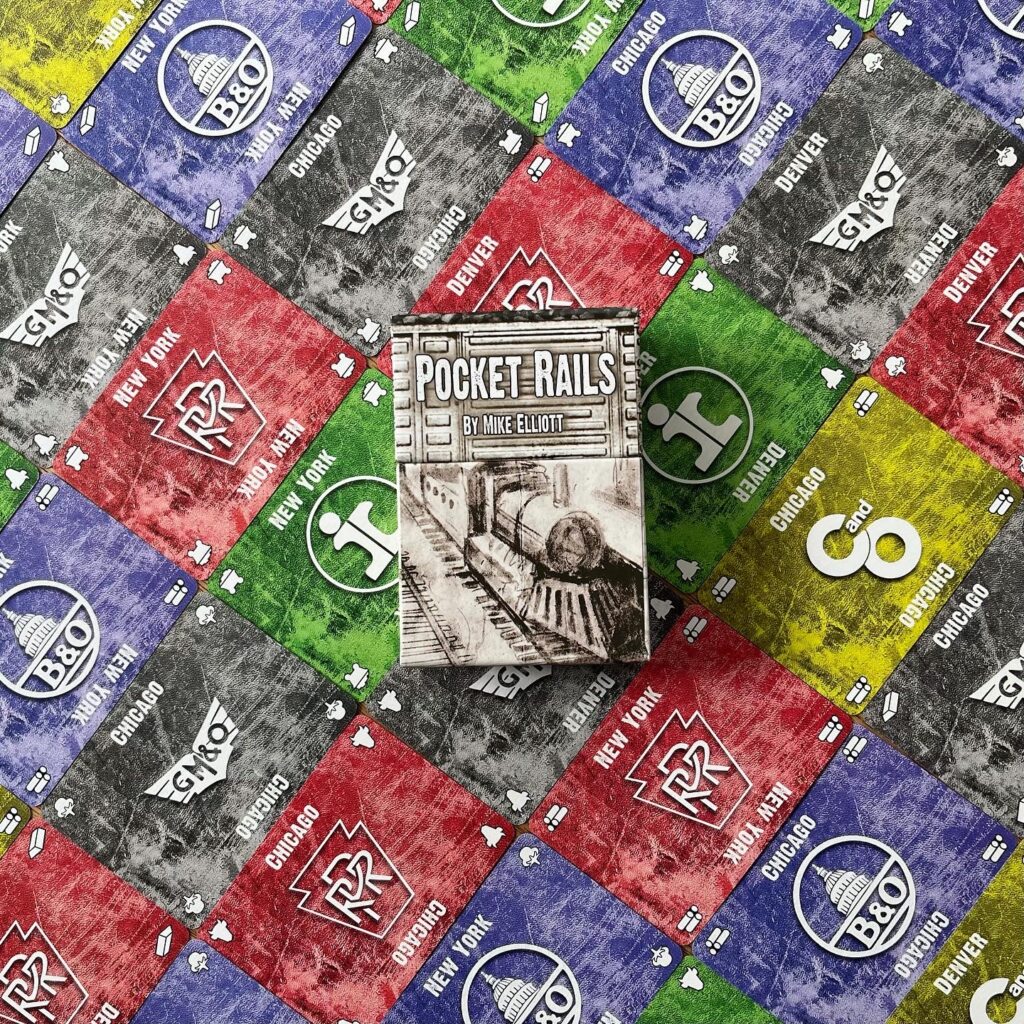Choo choo! Are you looking for a card game full of stocks, railways, bluffing, cheating and risk? Do you like it when game fits quite easily in your pocket and allows you to potentially blow off some steam? Then get your tickets cut quickly and hop on board!
Background and goal
You may have seen this name/definition pop up before, but 18XX games are games for heavy, soot-covered train spotters, conductors and locomotive lunatics. But what exactly are these 18XX games? 18XX refers to a type/genre of board games where players recreate the construction of railway companies in the 19th century. These are not Tickets to Ride where players run nicely over the rails, but heavy economic games where trains mainly occupy a siding and players have to trade goods, currency and shares to become a real wagon magnate. It all started with 1829 – an economic game by designer Francis Tresham. This was followed in 1986 by Avalon Hill’s game 1830, based on the 1829 game system.

These railway games became so popular that it derailed considerably after 1830, multiple creators jumped on the bandwagon and by now you could fill an entire train graveyard with 18XX games. Most of these games have the same theme, but there are also games set in other eras and even with completely different settings. The 18XX games share basically similar game mechanics, often the same theme, a complex and economic nature and a similar title.
So what does this have to do with Pocket Rails? Many elements can be traced back to the 18XX games, but in a handheld format. The box shows off a train and rails entirely in that 19th century vibe, the lid is a wagon, and in the game, players start trading shares in various railway companies and score points for their stock and collected goods. In doing so, they do have to watch out for overproduction in the various cities, diversify their portfolio and guard against insider trading. This may sound almost as complex as an 18XX game, but that is not so bad: it is mainly the theme that travels on a parallel track.
Set-up and gameplay
Pocket Rails is easy to set up. After all, the game consists only of a pack of cards. Each card shows a company (the colour of the card corresponds to the company) a good and a city. You will score with the companies and goods, but the cities may cause overproduction. By the way, the box lid does have a purpose and namely acts as a kind of priority spy during the game.
Each player receives a card at the beginning of the game: this is inside information and affects the score during the final round. The game is played in three rounds. During each round, you are given a hand of cards. You choose two cards each time, one of the chosen cards is placed face down in front of you and the other card is placed face down in the middle of the table. You pass on the remaining cards. This continues until all the cards of that round have been dealt. The cards are turned face up and at the end of rounds 2 and 3 there is a scoring phase.
At the end of a round, before the scoring, cards may also ‘disappear’. Players must discard cards if they have three cards depicting the same company and city. Cards from the centre of the table (the rail yard) are discarded when a company is active in each city.

Simple right? You would think! The scoring, and therefore the choice of how to keep cards, is not always so simple. You score points for your companies times the companies in the rail yard. Goods are also scored in a similar way, but the good that occurs most often in the rail yard does not count. You also score points for the good that occurs the most. In the scoring in the final round, your prior knowledge card also counts. This time, you don’t score points for the company on your insider card, but you do score extra for the depicted good.
Verdict
The gameplay of Pocket Rails is very simple, but the complexity is mainly in the calculation of the scoring and thus choosing and discarding just the right cards. This might be daunting at first, as in the first few games you are mostly busy understanding and implementing the scoring system itself. In the first few games, you might be busy counting and calculating, but after a few games have been played, the scoring goes a lot faster and you won’t lose track.
In Pocket Rails, players are mostly picking their brains about putting together a healthy portfolio of stocks. Since the cards depict different combinations of companies, goods and cities, this is quite a puzzle. On the one hand, you have to diversify to ensure that your cards will not be removed due to overproduction, but on the other hand, you also have to take the risk of not spreading your chances too much in order to actually score as high as possible. Players have to take many elements into account as a result. One of the elements, of course, is your opponents. Players have to keep a close eye on deducing what other players are up to. What other players discard on the rail yard has an impact on the score and on overproduction. By making a good selection of cards, you can put other players on the wrong track and derail their strategy. This card game is therefore suitable for those players who like 18XX-like themes, but like to play a fast paced card game and like to tease their brains about the odds of their investment.



